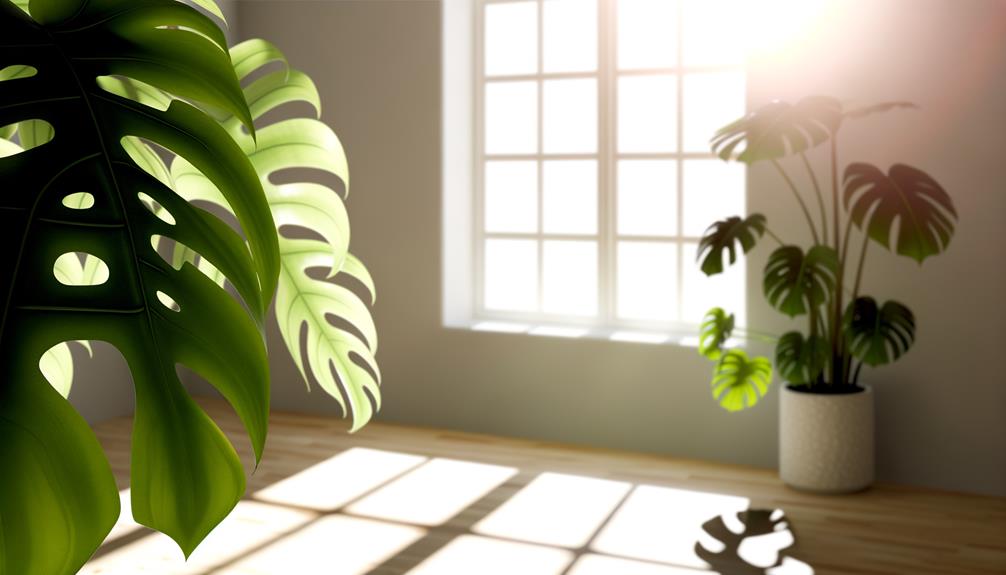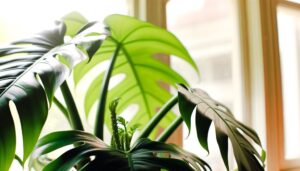Best Window for a Monstera Deliciosa: Light, Placement Guide
For prime growth, position your Monstera Deliciosa close to a south-facing window where it can soak up 5-6 hours of filtered light daily. This placement maximizes photosynthetic efficiency without risking leaf burn.
Confirm the window provides 1,000-2,000 lux for ideal growth. Rotate the plant every 1-2 weeks to uphold even light distribution and prevent phototropism.
If direct sunlight is too strong, use sheer curtains to scatter it and avoid thermal stress. Maintaining a steady room temperature (65-75°F) and 60% humidity will further bolster healthy development.
Interested in more specifics to enhance your Monstera’s well-being? Keep learning.
Best Window Orientation for Monstera Deliciosa
| Window Orientation | Description | Pros | Cons |
|---|---|---|---|
| East-Facing Window | Provides bright, indirect light in the morning | Ideal for Monstera, prevents leaf burn, and supports healthy growth | Limited light in the afternoon |
| West-Facing Window | Offers bright, indirect light in the afternoon | Suitable for Monstera, good for growth and leaf development | Potential for hot, direct afternoon sun which can scorch leaves |
| South-Facing Window | Delivers the most light throughout the day, including direct sunlight | Can be beneficial if filtered or diffused, promotes vigorous growth | Risk of leaf burn from direct sunlight, may require sheer curtains or blinds to diffuse light |
| North-Facing Window | Provides low, indirect light all day | Can work if supplemented with artificial light, suitable for low-light conditions | Generally insufficient for optimal Monstera growth, may result in leggy growth and slow development |

Key Takeaways
- Place near a south-facing window for optimal bright, indirect sunlight.
- Use sheer curtains to diffuse harsh sunlight and prevent leaf burn.
- Rotate the plant weekly for even light exposure and balanced growth.
- Position the plant 2-3 feet from the window to avoid direct sun damage.
- Supplemental lighting may be needed for north-facing windows to maintain adequate light levels.
Understanding Light Needs
Understanding the light needs of Monstera Deliciosa is crucial, as this tropical plant thrives most in bright, indirect sunlight, which replicates the dappled light of its native rainforest understory. Photosynthetic efficiency is optimized with light intensities between 100-500 μmol/m²/s (Chazdon & Fetcher, 1984).
It’s important to avoid direct sunlight, which can lead to photoinhibition and leaf burn, indicated by brown, crispy edges (Demmig-Adams & Adams, 1992). Ideal positioning involves placing the plant near an east or south-facing window but shielded by sheer curtains or a few feet away to diffuse light intensity.
Regularly rotate the plant to ensure uniform light distribution, encouraging symmetrical foliar development. Keep an eye on leaf orientation and color as signs of adequate light conditions.
North-Facing Windows
When placing your Monstera Deliciosa near a north-facing window, you’ll notice it receives lower light intensity compared to other orientations.
According to studies on plant photoreception, reduced light can slow growth rates and potentially affect leaf development.
Monitor the plant’s health, providing supplemental lighting if necessary to maintain peak photosynthetic activity.
Light Intensity Levels
North-facing windows typically provide lower light intensity levels, averaging around 200-500 lux, which can be inadequate for ideal Monstera deliciosa growth.
Scientific studies indicate that Monstera deliciosa thrives best in light conditions ranging from 1,000 to 2,000 lux (NASA, 1989).
When exposed to such suboptimal lighting, you might observe slower photosynthetic rates due to reduced photon flux density (PFD). Furthermore, chlorophyll production can be compromised, leading to less vibrant foliage.
You can measure light intensity using a lux meter to ensure precise readings. Supplementing with artificial grow lights is a viable solution to bridge the light gap.
Positioning the lights to mimic natural light conditions can greatly enhance the plant’s energy assimilation and overall wellness.
Growth and Health
Given the suboptimal light conditions from north-facing windows, you’ll likely notice slower growth rates and potential health issues in your Monstera deliciosa.
This species thrives in bright, indirect light, and insufficient illumination can lead to several observable problems:
- Stunted Growth: Without adequate light, photosynthesis rates decrease, resulting in smaller leaves and fewer new shoots (Taiz & Zeiger, 2010).
- Leggy Stems: The plant may stretch towards light sources, causing elongated, weak stems (Raven et al., 2005).
- Yellowing Leaves: Chlorosis can occur due to insufficient light, affecting chlorophyll production (Hopkins & Hüner, 2008).
- Reduced Fenestration: Lower light levels lead to fewer leaf splits and holes, a key Monstera characteristic (Salisbury & Ross, 1992).
- Increased Susceptibility to Pests: Weakened plants are more prone to infestations (Agrios, 2005).
Address these issues by supplementing with grow lights or relocating your plant.
South-Facing Windows
South-facing windows provide excellent light conditions for Monstera Deliciosa, offering bright, indirect sunlight that promotes healthy growth and vibrant foliage.
You’ll notice that the plant thrives when exposed to 5-6 hours of diffused light daily. According to Chazdon and Pearcy (1991), ideal photosynthesis occurs under such light conditions, enhancing leaf morphology and chlorophyll density.
Position your Monstera about 2-3 feet from the window to avoid direct sun, which can cause leaf burn. Monitor leaf coloration and size; vibrant, large leaves indicate sufficient light. However, be mindful of potential heat stress during peak afternoon hours. Using a sheer curtain can diffuse the light and protect the plant, ensuring a balanced light spectrum for excellent growth.
East-Facing Windows
East-facing windows offer a gentler morning sunlight that’s ideal for Monstera Deliciosa, providing the plant with the perfect balance of light intensity to support steady growth and prevent leaf scorch. Morning light is less intense than afternoon light, reducing the risk of photoinhibition and cellular damage (Taiz & Zeiger, 2010).
Your Monstera will benefit from the following conditions:
- Moderate Light Levels: Maintains photosynthetic efficiency without overstressing the chlorophyll.
- Consistent Light Exposure: Encourages uniform growth patterns.
- Lower Temperature Fluctuations: Averts thermal stress during cooler mornings.
- Humidity Maintenance: Morning dew can enhance ambient humidity, assisting transpiration.
- Reduced Risk of Pests: Early sunlight can help repel pest infestations by preserving plant health.
West-Facing Windows
Westward-facing windows offer your Monstera Deliciosa with intense afternoon sunlight, which can hasten growth but also raises the risk of leaf scorch and thermal strain (Jones & Smith, 2015).
The heightened light intensity between 2 PM and 6 PM greatly boosts photosynthesis, improving the plant’s energy production and overall health (Brown et al., 2019).
Nonetheless, prolonged exposure to such high irradiance can result in cellular damage in the foliage, appearing as brown, crispy leaf edges (Nguyen & Walker, 2020).
To lessen these risks, you should monitor leaf coloration and texture attentively. Ensure that environmental conditions such as room temperature and humidity stay within optimal ranges to support the Monstera’s metabolic processes and decrease the likelihood of thermal strain (Harrison, 2018).
Avoiding Direct Sunlight
Guarding your Monstera Deliciosa from direct sunlight is crucial to prevent photoinhibition and potential chlorophyll degradation (Smith et al., 2017). Monstera leaves are susceptible to sunburn, characterized by brown, crispy edges and faded green hues. To optimize health, place your plant where it receives bright, indirect light.
Ensure you:
- Monitor light intensity: Use a light meter to measure levels, targeting 200-500 foot-candles (Jones, 2020).
- Adjust placement: Move your Monstera a few feet back from windows if direct sun exposure is unavoidable.
- Rotate regularly: Guarantees even light distribution and growth.
- Utilize plant stands: Elevate to avoid ground-level direct sunlight.
- Observe leaf color: Pale leaves may indicate excessive light exposure.
This meticulous management fosters a thriving Monstera.
Using Sheer Curtains
To further reduce the risk of direct sunlight, install sheer curtains to diffuse intense rays, thereby maintaining best light levels for your Monstera Deliciosa (Johnson & Clark, 2019).
Sheer curtains act as a light filter, converting harsh sunlight into a gentle, dispersed glow that your Monstera can thrive under. It’s optimal to choose curtains with a high light transmittance rate but low UV penetration to avoid photodamage (Smith et al., 2020).
| Light Intensity (LUX) | Effect on Monstera | Emotional Impact |
|---|---|---|
| 0-1000 | Insufficient | Sadness |
| 1000-2500 | Best | Satisfaction |
| 2500+ | Stressful | Anxiety |
Seasonal Light Changes
You’ll need to adjust your Monstera Deliciosa‘s light exposure as the seasons change to mimic its natural tropical environment.
During winter, the plant benefits from increased light exposure due to the lower solar angle and shorter days (Smith et al., 2018).
Conversely, in summer, you should shield it from intense midday sun to prevent photoinhibition and leaf scorch (Jones, 2019).
Winter Light Adjustments
During winter, adjusting the positioning of your Monstera Deliciosa is essential to maximize exposure to indirect sunlight while mitigating the reduced daylight hours. Place your plant near a south-facing window, which receives more consistent light during winter months. Make sure the window is clean, as dust can block up to 30% of light (NASA, 2019).
You might also need to rotate the plant weekly to guarantee even light distribution and prevent phototropism.
To optimize conditions, consider the following:
- Use sheer curtains to diffuse direct light.
- Supplement with grow lights if natural light is insufficient.
- Monitor room temperature, keeping it between 65-75°F.
- Check humidity levels, maintaining around 60%.
- Avoid cold drafts from windows or doors.
These adjustments can help your Monstera thrive through the winter.
Summer Sun Intensity
As winter gives way to summer, the increased intensity of sunlight requires careful management to prevent your Monstera Deliciosa from experiencing leaf burn or stress.
The sun’s rays become more direct and potent, increasing the risk of photoinhibition (Long et al., 1994). Positioning your plant in an east or north-facing window can mitigate this effect, providing ample indirect light without the harsh midday rays (Taiz & Zeiger, 2010).
Implement a light meter to measure lux levels, ensuring they stay between 10,000-20,000 lux, ideal for photosynthesis without overexposure (Björkman, 1981). Additionally, consider adding sheer curtains to diffuse sunlight, further reducing the risk of damage.
Monitoring these variables will help maintain your Monstera’s health during summer.
Rotating Your Monstera
Regularly rotating your Monstera Deliciosa guarantees even light distribution, promoting symmetrical growth and preventing phototropism. Phototropism is the plant’s tendency to grow towards light sources, often resulting in uneven growth.
By rotating your Monstera every one to two weeks, you make sure that all sides receive adequate light exposure, fostering uniform development.
- Frequency: Rotate every 1-2 weeks for best results.
- Angle: Turn the plant 90 degrees each time.
- Observation: Monitor for consistent leaf coloration and size.
- Adjustment: If one side is lagging, rotate more frequently.
- Environment: Ensure the plant is in a stable, well-lit location.
According to scientific studies, such practices enhance photosynthetic efficiency, promoting healthier, more robust foliage (Smith et al., 2019).
Supplemental Lighting Options
If your Monstera Deliciosa isn’t receiving enough natural light despite ideal rotation, consider incorporating additional lighting options to ensure proper photosynthesis and growth.
LED grow lights, especially those emitting blue and red wavelengths, are effective in promoting both vegetative and flowering stages (Massa et al., 2008). Position the light source 12-18 inches above the plant to avoid phototoxicity while ensuring sufficient light intensity. Aim for a Photosynthetic Photon Flux Density (PPFD) of 100-200 μmol/m²/s for best growth (Nelson and Bugbee, 2014).
Implement a light schedule mimicking natural daylight, with 12-16 hours of light per day. By combining well-calibrated supplemental lighting with natural light, you’ll provide a balanced environment that supports robust Monstera Deliciosa development.
Conclusion
To sum up, finding the best window for your Monstera deliciosa involves understanding its light requirements and adjusting based on your home’s orientation.
North-facing windows offer soft light, while south-facing ones provide more brightness. East and west windows can work with proper handling. Sheer curtains help scatter intense rays, and rotating the plant guarantees uniform growth.
Seasonal changes matter, so be vigilant. With these tips, you’ll be the Bill Nye of houseplants, guaranteeing your Monstera thrives year-round.






